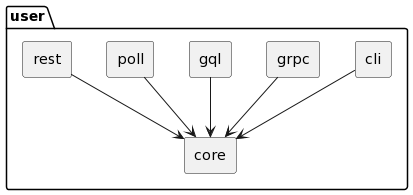Atomic domain modules
The post on organizing backend code covers the broad strokes of setting up the directory structure for a backend codebase. This post focuses on “leaf nodes” in the module dependency hierarchy: atomic domain modules. For example, in a codebase with the following modules:
domain/
platform/
user/
tenant/
The atomic domain modules are user/ and tenant/.
Domain encapsulation
An atomic domain module contains all code related to a given domain. It interacts with other modules through well-defined APIs. For inputs and outputs, it sends and receives scalars and data transfer objects (DTOs) rather than raw database records.
Deployment
It’s easiest to get up and running with all domain modules deployed as part of a monolith. But I like to design the system in such a way that it is possible to peel off individual domain modules into separate services. Even if it’s not necessary to break out into services, aiming for that possibility encourages modularity.
Database interactions
The following should be avoided across modules:
- Transactions
- Joins during queries
- Foreign key constraints
There are some exceptions here, which we’ll save for another post.
Directory structure
user/
cli/
core/
grpc/
gql/
poll/
rest/
Dependency hierarchy

core/
The core business logic for the module, agnostic of the entry point. All other submodules within user/ depend on this one.
user/
core/
# Fakers and seeders can be used to generate
# and seed fake data in development.
dev/
user.faker.ts
user.seeder.ts
# Data transfer objects (DTOs) should be used
# for cross-module interactions.
dto/
user.dto.ts
user-revised.payload.dto.ts
# Service classes for writing into the database.
mutate/
user.create.service.ts
user.update.service.ts
# Service classes for reading from the database.
query/
user.query.service.ts
# Elasticsearch document definition and config.
search/
user.es-dto.ts
user.es-reindexer.ts
user.searchkit-config.ts
# Database schema.
user.prisma
# The "core" business logic module for this domain.
user.module.ts
cli/
Command-line interface. This could include a runner file so that the CLI for this module loads only its immediate dependencies.
user/
cli/
cli-create-user.ts
cli-user.module.ts
user-cli.runner.ts
gql/
GraphQL types and resolvers.
user/
gql/
gql-user.type.ts
gql-user.resolver.ts
gql-user.module.ts
poll/
Pollers, including event consumers.
user/
poll/
poll-user-tenant-revised/
poll-user-tenant-revised.module.ts
rest/
The REST API surface.
user/
rest/
rest-user.controller.ts
rest-user.module.ts
PlantUML source
@startuml
skinparam map {
BackgroundColor white
}
skinparam componentStyle rectangle
package user {
component cli
component grpc
component gql
component poll
component core
component rest
}
grpc --> core
gql --> core
cli --> core
poll --> core
rest --> core
@enduml